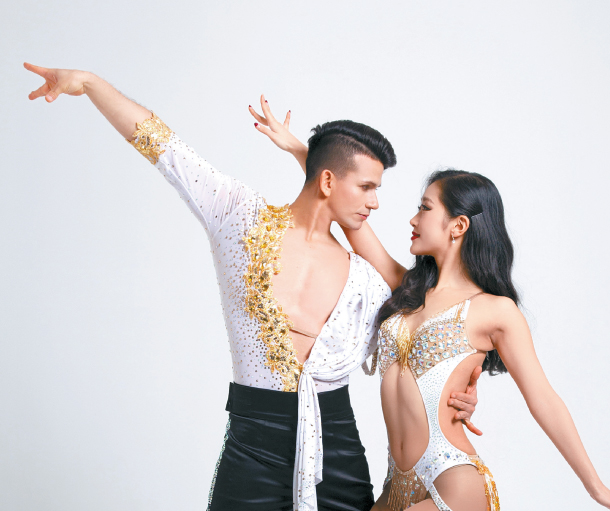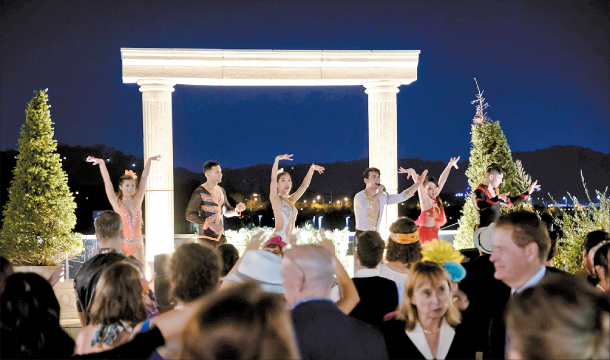Diversity makes Seoul Asia’s dancing capital: Latin dance groups offer community for foreigners, locals alike

When he was leaving town on Monday morning, he “had a list of places I had scheduled to go [to] next and a list of friends. [Dance] was the most amazing vehicle for networking and integrating into a new city,” he said.
Quantrill’s experience encapsulates the vibrant energy of Seoul’s social partner dancing scenes, where every night of the week different people and cultures meld together on the dance floor.
While the Korean commercial hip-hop dance scene has gained worldwide attention with the help of viral K-pop music videos and the popular 1MILLION Dance Studio, Seoul is known as Asia’s dance capital for another reason - the various social partner dance communities here have deep roots in the city going back as far as a couple decades. The most prominent of the communities are salsa and bachata - two Latin dances that are often paired together - Argentine tango, swing and most recently, urban kiz.
While this flourishing culture has attracted many people from around the world to come to Seoul, it’s still difficult to get updated on weekly events without a familiarity with the Korean language, as most information is posted on the local online portals of Daum or Naver. Although there is some information in English posted to Facebook or Meetup groups online, it is difficult to know where to start.
To bridge this gap, some teachers in the city have made dance more accessible to foreigners, introducing them to new dance styles, growing their social circles and building inclusive dance communities.

From left: Dancers attend SA Latin’s weekly pop dance class in Hongdae, western Seoul; SA Latin owner Noble, center, teaches a class at the club’s monthly Latin Fiesta event at Seoul Marina in western Seoul; South African kizomba instructor Richard Quantrill dances at the Namambo club in Gangnam District, southern Seoul. [SA LATIN, FREE ANGEL]
After moving to Seoul in 2017, Jhonatan Jimenez, a professional dancer of over 20 years from Colombia, wanted to teach people in Korea not only about Latin dance, but also the culture, history and music that provide the foundation to understanding the art forms.
Beyond just classes, Jimenez has in the process also cultivated an international Latin dance community through his dance school, the Jhonatan Dance Company (JDC).
Starting with just three students three years ago, Jimenez now has over 150 students. JDC offers salsa, bachata, reggaeton Latin flow, power shine and Argentine tango classes, along with private lessons and master training programs, all around Seoul and beyond - in Hongdae, Gangnam, Songdo in Incheon and Yongin, Gyeonggi. Most recently, JDC established its own studio in Gangnam, where Jimenez hopes to “give people a place for studying, enjoying and having our own home.”
Together with his co-teacher Jane Sung, who is one of Jimenez’s former students, JDC also puts on performances and big events in the city, while organizing casual parties and social dance outings with members. While the students who come to JDC speak at least some English or Spanish, Jimenez emphasizes, “It doesn’t matter the age [or] where you’re from. Everybody is welcome to JDC. [We] make a community that [we] can enjoy together.” At one of JDC’s Saturday salsa classes at the new studio, a diversity of ages, nationalities and dance experience mix seamlessly in a comfortable atmosphere.
However, Jimenez is just getting started. While salsa has been in Seoul for over two decades, he says that the overall Latin dance scene can grow to become more inclusive and prevalent in the future, which is why Jimenez hopes one day to open a dance academy to teach children to become professional dancers. “[When I was growing up] in Colombia, we had a lot of war. So one [of] my dreams when I was a child [was] to see people happy,” he said. “I wish that one day we can spread the beauty of Latin dance with all Koreans, because I feel like the world needs more peace, love and dance.”

Above: The Jhonatan Dance Company (JDC) performs at the Havana Night-themed event organized by the Dwight School Seoul Parents’ Association at Marina Park near the Han River. Right: Jhonatan Jimenez, left, and his co-teacher Jane Sung manage JDC, which puts on performances, social events and classes all around Seoul. [JHONATAN JIMENEZ, JDC MARKETING]
From Latin dance bar Tension in Hongdae to the Yongsan Garrison in central Seoul, a Korean Latin dance group is bridging cross-cultural barriers. SA Latin is one of many Korean community clubs, but its owner, who goes by Noble and is fluent in Korean and English, wanted to make the club more accessible to foreigners in Korea by providing English-language Latin dance classes and by posting English-language information online.
“I wanted [the foreign community] to find a place that they [can] feel comfortable, relieve stress and get to know some friends - foreigner friends and also Korean friends - so they can get used to living in Korea,” he said.
Established by Noble and his partner three and a half years ago, SA Latin provides various classes in salsa, bachata and pop dance at different skill levels throughout the week in Hongdae and in Itaewon-dong, central Seoul.
On Saturdays, Noble teaches English-language salsa and bachata classes at the Yongsan Garrison, which are open to anyone, if they are cleared by the base to enter. SA Latin started facilitating these classes two and a half years ago when the Garrison wanted to continue their Latin nights programming after former teachers left. The classes will be held in Hongdae starting in March.
In every class, SA Latin and Noble make the effort for inclusivity, helping their international members in both understanding more about dance and adjusting to life in Korea. Having lived in the United States for many years, Noble says, “I know what kind of troubles a lot of foreigners in Korea can face. I can’t solve anything, but I can listen and give advice from the point of view that knows Korea but also understands their perspective.”
Outside of classes, SA Latin hosts parties and socials, making the club an integral part of life in Seoul for its international members, who make up around 10 percent of the club.
“Whenever [members’] families come over to visit Korea, they always bring their families to SA Latin. That dancing and interacting with people in SA [Latin] is really a part of their lives [that] they want to share with their families,” says Noble.
Maintaining tradition
Down some unassuming stairs and into a cozy Itaewon-dong speakeasy bar called Volstead, a kizomba party is happening every Sunday night. This foreigner-friendly event hosted by Global Kizomba offers beginner and intermediate kizomba dance classes, followed by hours of social dancing.
The classes mainly teach the traditional form of kizomba, a type of dance with Angolan origins, with some mix of urban kiz. The latter evolved from kizomba and grew with influences of newer music styles like electronic, R&B and hip-hop. Urban kiz is one of the newest scenes to pop up in Seoul starting three or four years ago, and nowadays, socials take place nearly every day of the week.
Taught by the main Global Kizomba organizer Shin Bu-hyeon, who speaks Korean, and Quantrill, a former figure skater and dance instructor from South Africa, who speaks English, the Sunday event provides a welcoming atmosphere for all types of people, with around 40 percent of dancers being foreigners and 60 percent locals.
Quantrill says there are many opportunities to socialize, especially as local customers can still enjoy the Volstead bar during the kizomba social. After dancing, people often continue the night by eating a meal together.
“I feel we’re creating a regular, reliable place for people to come and enjoy socializing and the music,” says Quantrill.
Occasionally, even diplomats or ambassadors from Angola come to enjoy the event, as Global Kizomba has ties with the Angolan Embassy. “They really like our event because we’re focused more on the traditional side of things. It’s a taste of home for them,” adds Quantrill.
Although the kizomba and urban kiz scene hasn’t yet taken off in the way other prominent scenes in Seoul have, Quantrill still enjoys seeing the scene develop and having helped the levels of dancers increase for the genre.
Meanwhile, there’s still an enormous swing dancing scene in Asia’s dance capital, as 15 dance halls within the city hold two to three socials a week, and groups like Swing Pop offer communities where locals and foreigners can take classes and dance together, says member Marita Arnold.
For Argentine tango, Seoul remains “the biggest and best tango community in terms of levels and skills in Asia,” says tango teacher Emilio Andres Araya, and multiple tango parties also take place every single night.
Even Brazilian zouk, which has recently made small steps in Korea, may grow more prominent in the future.
With this much diversity, Seoul can be a gateway for both visitors and locals to make dance a personalized journey within this city constantly on the move.
BY REBECCA CHENG [rebeccacheng2@gmail.com]










with the Korea JoongAng Daily
To write comments, please log in to one of the accounts.
Standards Board Policy (0/250자)